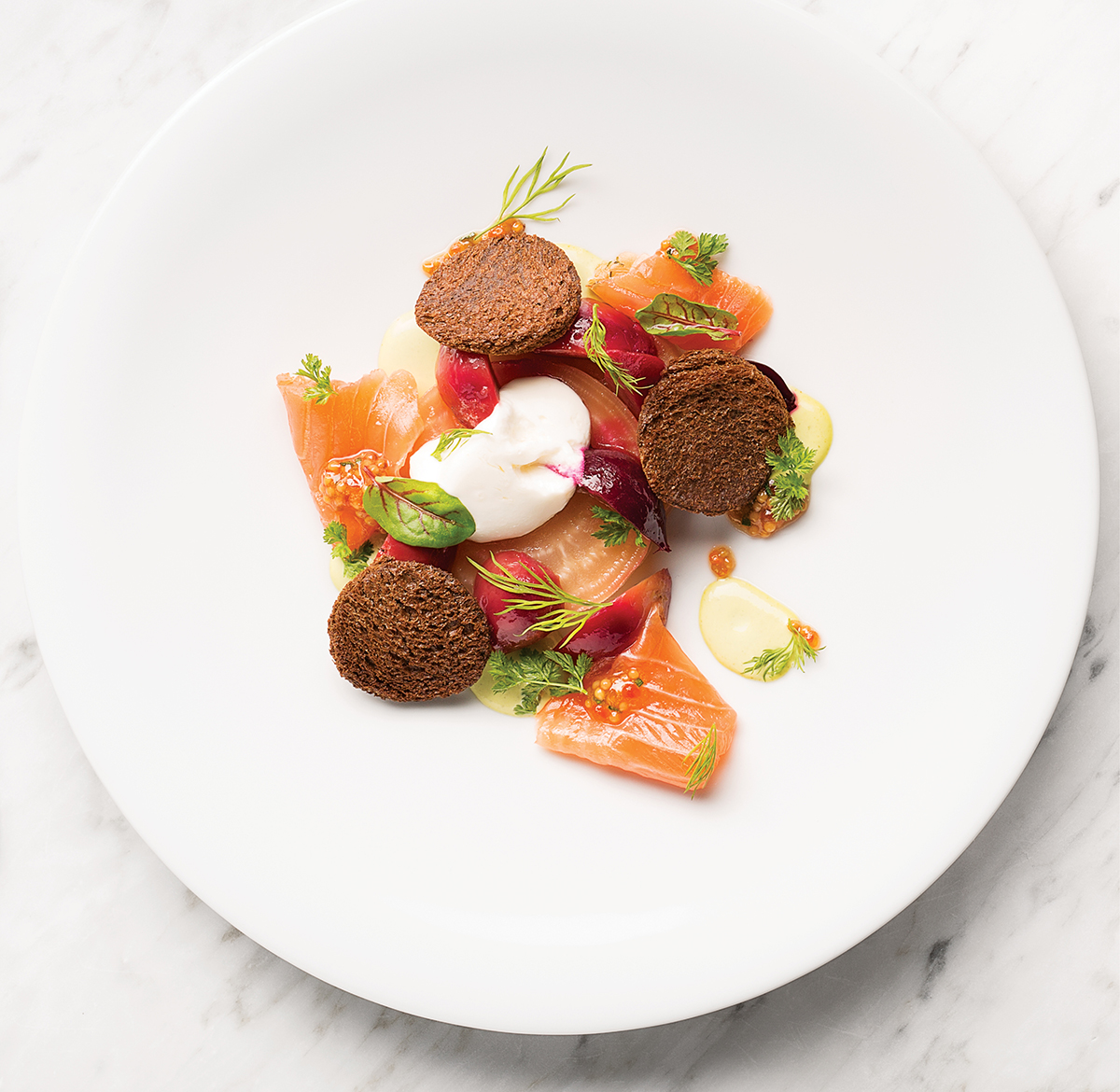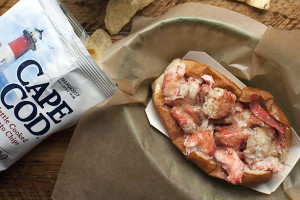Restaurant Review: Café ArtScience

Jewel-toned beets are matched with curls of smoked salmon in a first-course salad. (Photograph by Jared Kuzia)
Café ArtScience is unlike any other restaurant—in Boston, but also the world. It’s a classroom, a lab, a multimedia conference center, a modern cocktail bar, and…have I left anything out? The starring cast members—chef Patrick Campbell, general manager Tom Mastricola, bar director Todd Maul, and David Edwards—make for an intriguing story. Edwards, a biomedical engineer and Harvard professor who developed inhalable insulin, sold his startup for $114 million, and moved to Paris. (Wouldn’t you?) There he opened Le Laboratoire, a gallery-café where you can experience inventions such as Le Whaf, which allows you to inhale vaporized flavored liquids. Last summer, Boston food editor Leah Mennies traveled to Paris with the foursome to witness the genesis of Le Laboratoire Cambridge, the big new Kendall Square space that houses Café ArtScience.
But how would all of these ambitions play out in a restaurant? To my great surprise, I found that, at its essence, Café ArtScience is a high-style French eatery serving meticulous, cosmopolitan dishes. The interior encompasses a wide range of ambitions. It was designed by frequent Edwards collaborator Mathieu Lehanneur (a Parisian resembling Ethan Hawke), assisted by two American architects—Zeke Brown and Josh Fenollosa—whose names appear with others’ in white-on-white 3-D letters that run down one wall like a late-1940s modernist museum exhibition. There are high windows, modular celadon-green curving velvet banquettes, and white marble tables veined with gray.
Much of the food is white and chic, too, but generally not experimental, with the notable exception of dessert. Patrick Campbell, the chef Edwards hired without ever tasting his food, works with passion, restraint, and finesse that reflect his long tenure as chef de cuisine at No. 9 Park—a clarity of intention that feels more Parisian than Bostonian. The staff has been trained to soothe skittish customers, like my guest who couldn’t determine what kind of food the place served from the website. “Well,” our server gamely said, “American and French. We try to be as responsible and sustainable as possible. We can tell you the name of the pig and the farm it came from. But we play down the bells and whistles”—a phrase several servers mentioned reassuringly. “We don’t want them to be overwhelming.” This approach may, frankly, be at odds with the widely publicized high-tech lab/restaurant conceit.

The bright, white space is filled with curving green velvet banquettes. (Photograph by Jared Kuzia)
However unexpectedly low-tech, much of the food is as high-skill and accomplished as anything being served in Boston restaurants. The care starts with the amuse-bouches. When I went in late winter, a celery-root velouté had the silken, creamy richness that velouté should have but seldom does, with delicate sieved shavings of egg yolk and mini sorrel leaves as garnishes. Oysters ($3.75 each) were coated with thinly grated fresh horseradish and a tingling, sweetly acidic granita of Meyer lemon and Tabasco. The granita’s very fine crystals melted into the oysters to create a magical balance of salt, hot pepper, and cool lemon in a modernist chef way— but one that required no modernism at all.
A small first course combined jewel-toned Siena Farms beets ($16), roasted and dressed with pickled mustard seeds and trout roe—their beads similar in size and shape, with complementary flavors—with roll-ups of nicely salty smoked salmon.
It was the roast chicken ($24) that sold me on Campbell. Served on a white plate, it featured two elegant pieces of breast with crisped skin over an intensely flavored, fork-coating jus, with small pieces of soft, sautéed fresh foie gras, artfully strewn chunks of chicken liver, grilled cipollini onions, savoy cabbage, and a few pieces of fresh chestnut. Each component on the plate was perfectly and simply executed: the foie gras with a lightly caramelized surface; the chewy but not tough chicken liver that had the courage to taste like liver; the floury but not mealy chestnuts. That’s true and classic French cooking. We don’t get it often. We should savor it.
The foie-gras-and-rabbit terrine, meanwhile, sold me on Café ArtScience as an entity. Campbell told me that to make the terrine so creamy, he whisks the soaked lobes of foie gras as they cook, mixes the smooth foie with rabbit meat, and layers that with more fresh rabbit meat and Aleppo pepper. The slice is then placed over pomegranate juice set with agar, and garnished with caramelized pistachios and cocoa nibs. It’s expensive at $28 but generous, and it’s a knockout. I haven’t had a foie gras terrine this memorable since Jean-Georges Vongerichten showed Bostonians what fresh foie gras could be at his first job in America, at the Lafayette hotel.
When it comes to other meat cookery, however, Campbell is less consistent. Roasted pork loin on a “duet of pork” ($32) was tough, low on flavor, and memorable only for the cinnamony cotechino sausage served with it. He’s weakest on fish—baked stuffed clams and tempura-battered mussels ($16) were all bread crumbs (the clams) or breading (the mussels), with almost no shellfish flavor. Mahi mahi ($23) was flabby and dull, with undercooked, rubbery pieces of squid in an unappealing, liquidy squid-ink broth.
But then Campbell returns to something simple and even homey, and it’s easy to keep falling in love. “Potato tartlet” ($19) is listed with almost no description, and it turns out to be mashed potatoes mixed with grated Comté cheese, piped into a flaky pâte brisée crust, and topped with black Perigord truffles. Oversize tortellini filled with house-made ricotta and braised pea greens in a clear, rich Parmigiano-rind broth ($18) tasted like something an ambitious Italian chef with a patient grandmother would make. Maybe training with pasta expert Barbara Lynch at No. 9 helped.

The foie-gras-and-rabbit terrine comes with caramelized pistachios and cocoa nibs. (Photograph by Jared Kuzia)
Desserts are where the modernism is meant to dazzle, in the hands of Renae Connolly. They’re pretty, like new-style Disney dioramas: a “petit macaron” ($12) featured rose-scented meringue piped onto lemony fresh yuzu cream, accented by a little garden of white chocolate disks and spherified raspberry gel. A tubular chocolate shell filled with soft banana cream and served with passion- fruit sabayon and gianduja powder ($13) was, like the macaron, fun to look at and poke your spoon into—but too fussy for the flavor it delivered.
Still, a bit of whimsy can be forgiven. More than forgiven. Café ArtScience is so far from the arch affectation the advance publicity suggested that I can forgive a lot more. I’m already sending everyone to CAS, for the same reason I sent them to Asta and Ribelle last year and the year before to Giulia: to know what’s happening in food, right here and right now.
Menu Highlights
Beets with smoked salmon • $16
Marinated oysters • $3.75 each
Foie-gras-and-rabbit terrine • $28
Potato tartlet • $19
Roast chicken • $24
650 E. Kendall St., Cambridge, 857-999-2193, cafeartscience.com.
Critic Corby Kummer—an editor at the Atlantic and author of The Pleasures of Slow Food—has been reviewing Greater Boston’s top restaurants in our pages since 1997.


